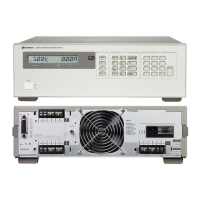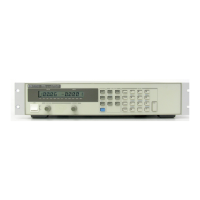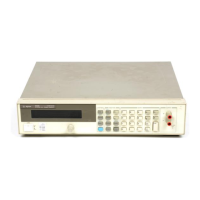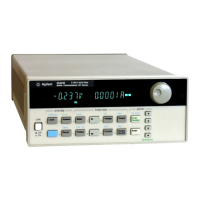As stated previously, the conduction of the series pass
transistors is controlled by the + BASE DRIVE and – DRIVE
inputs. Normally there is about a diode drop between these
two input pins. The current sources drive the series
regulator into conduction via the + BASE DRIVE input. The
– DRIVE input from the base drive circuit (see paragraph 2-
42) controls the amount of + BASE DRIVE current that
drives the series regulators in order to maintain a regulated
output. Any + BASE DRIVE current from the current source
that is not required by the series pass transistor to regulate
the output is drawn away by the control circuit through the
– DRIVE input via Q335. A level of current through Q335
that exceeds the + BASE DRIVE current can turn on the
power module current sink transistors to sink output
current up to the negative current limit value.
SCR Overvoltage Circuit –
The power module has an internal
SCR whose gate input is capacitively coupled to the OV
GATE pin. The OV GATE signal can fire the SCR for a
number of reasons which are described later under the
“Overvoltage Protection Circuit” paragraph. In addition to
shorting the output, the fired SCR will cause the OV SENSE
signal to go low signaling the microcomputer to program
the output to zero. The output will remain shorted and
programmed to zero until the circuit is reset. The SCR circuit
is reset when the POV DISABLE signal (OVRST command)
is received by the OV reset circuit (Q320). The condition that
caused the overvoltage must be removed in order for the
circuit to remain reset. If the condition is not removed, the
OV GATE signal will again fire the SCR and disable the
output. Note that in addition to resetting the SCR, the
OVRST command will program the output to the settings
that existed before the OV occurred.
Down Programmer
- Separate transistors in the power module
are used to sink output current and are capable of rapidly
down programming the output voltage to about 2 V. An
external FET down programmer circuit (see paragraph 2-49),
is connected across the output to continue down
programming the output voltage below 2 V.
Overtemperature Protection
- The power module also contains an
overtemperature circuit that consists of a negative
temperature coefficient thermistor that senses the power
module's temperature. When the power module's
temperature rises enough to reduce the THERM input
resistance to about 8 K ohms, the thermistor drops below 2.5
V (approximately) notifying the signal processor that an
overtemperature (OT) condition has occurred. The signal
processor then relays this information to the microprocessor
which will shutdown the particular output with the
overtemperature condition. The output will be restored 30
seconds after a safe operating temperature is reached.
Reverse Output Voltage Protection Diode
- The power module
contains a diode with its cathode connected to the
COLLECTOR output and its anode connected to the power
module COMMON. This diode is essentially connected
across the power supply's output terminals to protect the
output from having reverse voltages applied.
2-42 Peak Current Limit. This circuit Q321, Q322, R407, P/0
U340, quickly limits the amount of current through the
series regulator elements in the power module. It is
activated when the output current exceeds the full scale
value + about 75% in either the sourcing or the sinking
direction.
The series pass regulator in power module U338 is
connected in series with an external resistor (R407). When
the voltage across R407 exceeds a diode drop in either
direction, the peak current limit circuit is activated and
limits the conduction of the series pass transistor element or
current sink transistor. This circuit reacts much faster than
the + or--current control circuits (see paragraph 2-47).
When the peak current limit circuit is activated in the
current source direction, not only will the conduction of the
series regulator be limited, but the current control circuit
(U376) will be quickly activated through P/O U340, CR341,
U376 and R405 to take control of the current limiting action.
2-43 Bleed Circuit. This circuit (Q341, R456, etc.), connected
from + V to - 7 V, provides a fixed current of about 15 mA
through the series pass elements in the power module so
that they are never completely turned off. The bleed circuit
is activated via the power-on circuit when the ON/OFF
signal is high. The bleed circuit maintains stability with
large output capacitors under light loading conditions and
helps to keep the output impedance constant.
2-44 Sense Protect Circuit. This circuit (P/O U375 and
P/O U351) monitors the voltage from + V to + S and from -
S to - V. If either of these voltages exceeds 1.0 V, the sense
protect circuit will generate a signal which will fire the
overvoltage protection circuits and shut down the output
(see paragraph 2-50). This circuit prevents the output
voltage from being regulated at a value higher than the
maximum value for which it was designed.
2-45 Base Drive Circuit. When activated (ON/ OFF is at
approximately 2.4 volts), this circuit (Q335 and U348)
provides the - DRIVE input to the series regulator and
current sink transistors in the power module. The - DRIVE
input determines how much drive current (+ BASE DRIVE)
the power module will receive. The -DRIVE input is
controlled by either the voltage control (CV), current control
( + CL), or negative current limit circuits ( - CL).
2-11
_______
_____
Series Regulators –
The series regulator stages consist of series
pass transistors which regulate the voltage received from the
selected power rail. The power module automatically selects
the proper input rail depending upon the output voltage
required. For example, if the low rail is supplying current
and the output voltage exceeds the low rail minus about 2.5
V, the medium rail begins to raise the voltage on the
BYPASS input and supply current. Finally, if the output
voltage exceeds the medium rail minus about 2.5 V, the high
rail will begin to supply current.
Artisan Scientific - Quality Instrumentation ... Guaranteed | (888) 88-SOURCE | www.artisan-scientific.com

